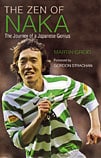 The Journey of a Japanese Genius
The Journey of a Japanese Genius
by Martin Greig
Mainstream, £16.99
Reviewed by Justin McCurry
From WSC 266 April 2009
Though sprightly in parts, Martin Greig’s biography of Japan’s most gifted footballer is too often the victim of the pitfalls inherent in crafting a book around protracted quotations and match reports.
The result is a work that is short on insight and long on minutiae, an unfortunate affliction for a book that promises to uncover the “Zen” of Shunsuke Nakamura, the prodigy from Yokohama now beloved of the Celtic diaspora. That said, Greig, a senior sportswriter at the Herald, has got his timing right. Celtic are in the reckoning for a domestic treble and Nakamura, a common factor in their successes of the past three seasons, will stay at Parkhead until at least the summer.
In pure football terms, too, Nakamura is more worthy of attention than other Japanese exports who, with the possible exception of Hidetoshi Nakata and Daisuke Matsui, contributed little more than a boost in merchandise sales, as the author wryly points out. In the foreword, Gordon Strachan says of his midfielder: “For pure ability Nakamura is the best footballer I have ever worked with.”
In encapsulating that innate ability, Nakamura’s 30-yard free-kick against Manchester United in the Champions League group stage in November 2006 is a good place to start, yet Greig tests our patience by milking the moment of every last drop of dramatic effect. As a literary device the montage – in this case a crawl through ten world cities to gauge the reaction of Celtic fans to the wonder goal – has been known to work in thrillers, but here it borders on the irritating.
Once Greig has established that the free-kick was indeed sublimely executed, he enters more comfortable territory, splicing facts about Nakamura’s upbringing and career with anecdotes and insights from those who know him best. Greig’s coverage of Nakamura’s formative years takes him to Japan, where we learn of his rejection as a youth by his local club, Yokohama Marinos, and his quiet determination to prove his doubters wrong.
It is the best part of the book, in which a picture emerges of a decent, if painfully shy, family man who, in that hackneyed observation of celebrated free-kick exponents, would rather stay out on the training field than join his team-mates for a drink. There are amusing vignettes, too, of the cultural and personal dissonance any Japanese player can expect in a faraway dressing room, not least his ill-advised acceptance of some chewing tobacco from Neil Lennon.
That is the nearest the book’s pivotal character gets to achieving the status of enfant terrible for, his visionary football aside, Nakamura’s unwavering modesty is hardly the stuff of a biographer’s dreams. That is not to say that the book wouldn’t have benefited from a deeper dig into his psyche. There is no discussion, for example, of how big an influence his widely reported membership of Soka Gakkai, a controversial Buddhist sect, had on his football, his relationships with his manager and team-mates, and even his attitude to injury and loss of form.
That’s a shame, as on occasions Greig is capable of flowing, evocative prose – on Nakamura’s struggle to make the grade as a youth player, his omission from Japan’s World Cup squad in 2002 and his three years in Italy with Reggina. In an early chapter Greig asks: Who is the real Nakamura? Yet 200-odd pages later, we are still some way off finding the answer.